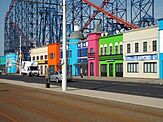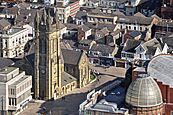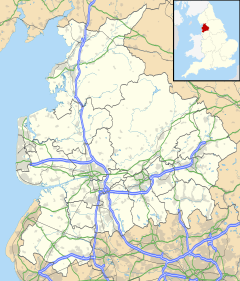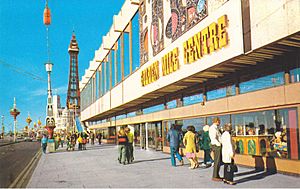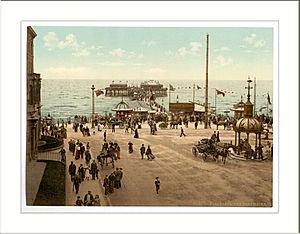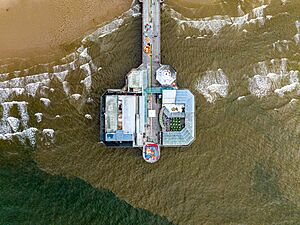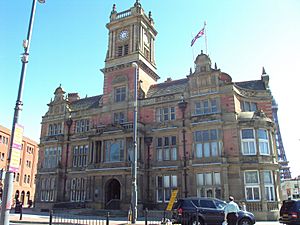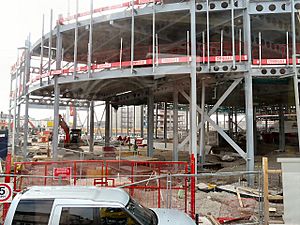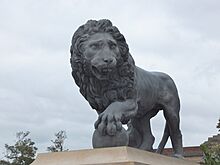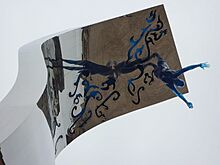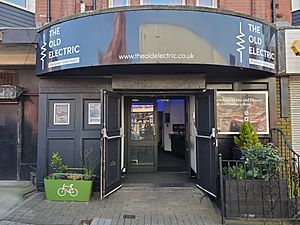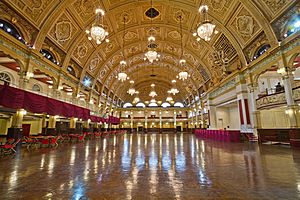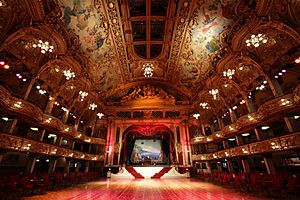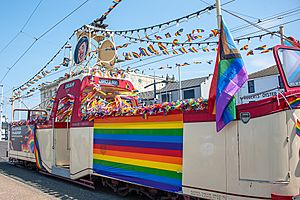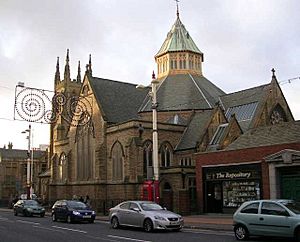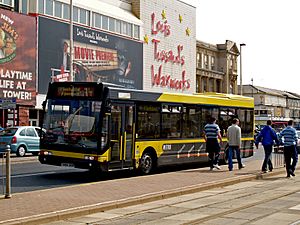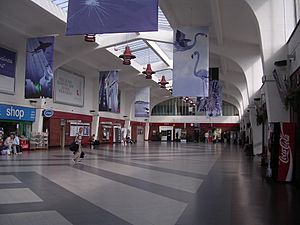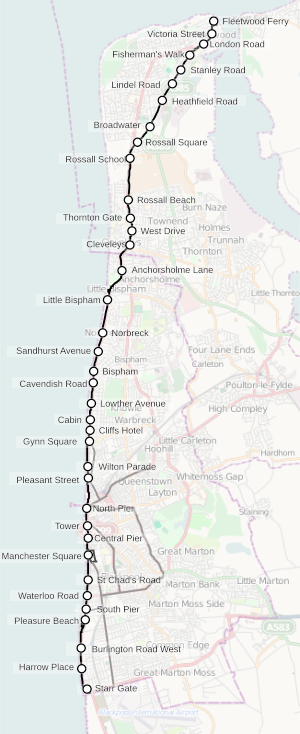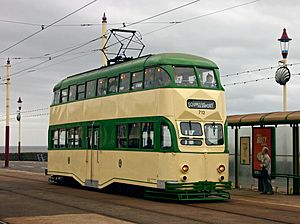Blackpool facts for kids
Quick facts for kids Blackpool |
|
|---|---|
| Town | |
|
|
|
| Area | 34.47 km2 (13.31 sq mi) |
| Population | 141,000 (2021 census) |
| • Density | 4,091/km2 (10,600/sq mi) |
| Demonym | Blackpudlian |
| Unitary authority |
|
| Ceremonial county | |
| Region | |
| Country | England |
| Sovereign state | United Kingdom |
| Post town | BLACKPOOL |
| Postcode district | FY1-FY5 |
| Dialling code | 01253 |
| EU Parliament | North West England |
| UK Parliament |
|
Blackpool is a fun seaside town in Lancashire, England. It's on the Irish Sea coast of the Fylde peninsula. Blackpool is about 27 miles (43 km) north of Liverpool and 14 miles (23 km) west of Preston. It is the main town in the area called the Borough of Blackpool.
Blackpool started as a small village. It began to grow in the mid-1700s when people thought bathing in the sea was good for their health. Blackpool's beach was perfect for this. By 1781, several hotels had been built. A railway station opened in 1846, bringing even more visitors. The town kept growing through the 1800s. In 1876, it officially became a borough.
Blackpool's growth was linked to the Lancashire cotton mills. Factories would close for annual maintenance, called wakes weeks. Many workers would then visit the seaside. The town grew a lot in the late Victorian and Edwardian times. By 1951, its population reached 147,000 people.
In the late 1900s, people started choosing different holidays. More people traveled overseas. This affected Blackpool's place as a top resort. Even with challenges, tourism is still very important to Blackpool. Today, Blackpool's seafront is famous for landmarks like Blackpool Tower and the Illuminations. Other popular spots are Pleasure Beach and the Winter Gardens. Millions of visitors still come every year. The town is also home to the Blackpool F.C. football club. In 2021, Blackpool's population was 141,000. This was a small decrease from 2011.
Contents
- Blackpool's History
- Blackpool's Geography
- Blackpool's People
- Governance and Politics
- Blackpool's Economy
- Blackpool's Regeneration
- Blackpool's Tourism
- Blackpool's Culture
- Blackpool's Sports
- Blackpool's Religion
- Blackpool's Education
- Blackpool's Transport
- Freedom of the Borough
- Images for kids
- See also
Blackpool's History
How Blackpool Began
In 1970, a 13,500-year-old elk skeleton was found. It had man-made bone points. This showed that humans lived on the Fylde a very long time ago. The Fylde was also home to a British tribe called the Setantii. Some of the first villages that became part of Blackpool were mentioned in the Domesday Book in 1086.
In medieval times, Blackpool was just a few farms on the coast. The name "Blackpool" came from "le pull," a stream. This stream drained water from Marton Mere and Marton Moss into the sea. The water was dark because it flowed through peatlands. So, the area became known as "Black Poole." In the 1400s, it was called Pul. A map from 1532 called it "the pole howsys alias the north howsys."
In 1602, church records from Bispham Parish Church first used the name blackpoole. The first important house, Foxhall, was built in the late 1600s. An Act of Parliament in 1767 set aside a common area. This area was mostly sand hills along the coast.
Sea Bathing and Resort Growth
In the 1700s, sea bathing became popular for health reasons. This brought visitors to Blackpool as a tourist resort. By 1788, there were about 50 houses along the sea. About six of these housed rich visitors. Other private homes took in people who came just for their health. By 1801, the town's population was 473. Henry Banks helped Blackpool grow a lot. He bought land in 1819 and built the first holiday cottages in 1837.
Blackpool in the 1800s
By the early 1800s, small places were built for middle-class visitors. But many working people from factory towns also loved Blackpool. A big change happened in 1846. A railway line to Blackpool from Poulton was finished. This made the town grow even faster as visitors arrived by train. Blackpool thrived with new hotels and attractions. It grew quickly in the 1850s and 1860s. A Board of Health was set up in 1851. Gas lighting came in 1852, and piped water in 1864. By 1851, the town's population was over 2,500.
North Pier opened in 1863. It was designed for Blackpool's "better classes." It has always been a quieter place than the other two piers. Over the next 50 years, two more piers were built: Central Pier in 1868 and South Pier in 1893. The Winter Gardens opened in 1878. Blackpool Tower opened in 1894. The first rides at Blackpool Pleasure Beach started in 1896.
Blackpool's Royal Palace Gardens at Raikes Hall was a famous place for variety and music hall shows. It had a Grand Opera House, an Indian Room for performances, and a Niagara café. There was also a skating rink, a fern house, and a fancy conservatory. It had a monkey house, an aviary, and an outdoor dance platform for thousands. The gardens also had paths with Greek and Roman statues. There was a boating lake and a racing track. Over 40,000 visitors came during its opening week in 1872.
Working-class tourists loved the center of the resort. It was the main holiday spot for workers from the industrial north and their families. Whole towns would close their factories during Wakes weeks. A different town would be on holiday each week. Communities traveled to Blackpool together, first by charabanc (a type of bus) and later by train. Blackpool also had a "significant middle-class market" in spring and autumn. These visitors preferred the North Shore area.
Blackpool's growth from the 1870s was shaped by its use of electricity. Electric lighting came to Blackpool in 1879. It became the world's first town with electric street lighting along Blackpool Promenade. This led to the famous Blackpool Illuminations. On September 19, 1879, 100,000 people gathered to see the promenade lit up.
Work started on the UK's first electric public tramway in Blackpool on February 24, 1884. The Blackpool Tramway officially opened on September 29, 1885. It was one of the world's first electric tramways. By 1899, the tramway grew, and the system was updated. The tram system is still running today. Blackpool was one of the first towns to use illuminated tram-cars for big events. Five trams were decorated with colored lights for Queen Victoria's Diamond Jubilee in 1897.
By the 1890s, Blackpool had 35,000 people and could host 250,000 holidaymakers. Important buildings like the Grand Theatre (1894) and Blackpool Tower were built. The Grand Theatre was one of Britain's first all-electric theaters. Many hotels were built during the Victorian and Edwardian periods. These included the Grand Metropole Hotel (1873), the Imperial Hotel (1867), and the Norbreck Castle Hotel (1912). These hotels are still open today.
In 1897, Blackpool Corporation stopped certain street sellers on Blackpool sands. These included "phrenologists" (people who claimed to read heads), "quack" doctors, palmists (fortune tellers), and mock auctions. These sellers moved to Central Promenade. They set up stalls in front gardens. This area became known as the Golden Mile. sideshows became a key part of it until the 1960s.
Blackpool from 1900 to 1960s
In 1911, the town's Central Station was the busiest in the world. In July 1936, 650 trains arrived and left in one day. In May 1912, Princess Louise opened a new part of North Promenade called Princess Parade. Lights were put up for the event. The First World War stopped the lights in 1914. But by 1925, the lights were back. Giant moving displays were added, making the Blackpool Illuminations almost six miles long.
Between the two World Wars, Blackpool grew and became a mature holiday spot. By 1920, Blackpool had about eight million visitors each year. Most still came from the mill towns of East Lancashire and West Riding of Yorkshire. Blackpool's population boom ended by 1951. By then, about 147,000 people lived in the town. This was a big jump from 47,000 in 1901 and 14,000 in 1881. In the 1920s and 1930s, Blackpool was Britain's most popular resort. JB Priestley called it "the great, roaring, spangled beast." It offered entertainment and places to stay on a huge scale. At its busiest, it hosted over 10 million visitors a year. Its entertainment venues could seat more than 60,000 people. During the Second World War, the illuminations were stopped again from 1939. They did not start again until 1948.
Blackpool stayed a popular resort through much of the 1900s. Unlike most resorts, it grew during World War II. It stayed open while others closed. Many government workers and military staff were sent to live and work there. The town kept attracting more visitors in the decade after the war. It reached a peak of 17 million visitors per year.
Blackpool from 1960s to Today
By the 1960s, UK tourism was changing a lot. More people chose package holidays and traveled abroad. The M55 motorway was built in 1975. This made Blackpool easier to visit for a day trip instead of an overnight stay. However, the town's economy still relies heavily on tourism.
Many seaside resorts struggled in the late 1900s. This was due to more travel options, more money, changing visitor desires, and more competition. But Blackpool managed to keep its popular appeal. It was sometimes called the "Las Vegas of the North."
Despite economic changes and challenges, Blackpool is still a popular seaside destination. Tourism in the town supports 25,000 full-time jobs. That's one in five of all jobs there. In 2023, Blackpool was named the UK's best-value holiday spot. In 2021, 18.8 million visitors brought £1.5 billion to the local economy. This made Blackpool the UK's biggest seaside resort. In 2022, the resort attracted 20.33 million visitors. They contributed £1.7 billion to the local economy and supported over 22,000 jobs.
Blackpool's Geography
Physical Features

Blackpool is in the middle of the western edge of The Fylde. This is a flat coastal plain on a peninsula. The seafront has a 7-mile sandy beach. The coastline is flat in the south. It rises past the North Pier to become the North Cliffs. The highest point is near the Bispham Rock Gardens, about 34 meters (112 feet) high. Most of the town is built up. There is very little open, natural space, like at Marton Mere. Because the land is low, Blackpool sometimes floods. A big project finished in 2017 to rebuild the seawall and promenade. This helps prevent flooding.
Climate
Blackpool has a temperate maritime climate. This means it has cool summers and often cloudy skies. Temperatures don't change much throughout the year.
The lowest temperature ever recorded was -15.1°C (4.8°F) in December 1981. However, -18.3°C (-0.9°F) was recorded in January 1881.
The highest temperature ever recorded in Blackpool was 37.2°C (99.0°F) during a 2022 United Kingdom heat wave. In an average summer, the warmest temperature reaches about 28.5°C (83.3°F).
It rains a bit less than 900 mm (35 inches) per year. There are over 147 days a year with more than 1 mm of rain.
| Climate data for Blackpool (BLK), elevation: 10 m (33 ft), 1991–2020 normals, extremes 1960–present | |||||||||||||
|---|---|---|---|---|---|---|---|---|---|---|---|---|---|
| Month | Jan | Feb | Mar | Apr | May | Jun | Jul | Aug | Sep | Oct | Nov | Dec | Year |
| Record high °C (°F) | 14.3 (57.7) |
18.4 (65.1) |
19.4 (66.9) |
24.4 (75.9) |
28.6 (83.5) |
31.3 (88.3) |
37.2 (99.0) |
32.2 (90.0) |
30.0 (86.0) |
26.2 (79.2) |
16.8 (62.2) |
15.0 (59.0) |
37.2 (99.0) |
| Mean maximum °C (°F) | 10.8 (51.4) |
11.1 (52.0) |
14.8 (58.6) |
19.0 (66.2) |
23.4 (74.1) |
25.5 (77.9) |
26.3 (79.3) |
25.2 (77.4) |
22.9 (73.2) |
18.7 (65.7) |
14.1 (57.4) |
11.7 (53.1) |
28.5 (83.3) |
| Mean daily maximum °C (°F) | 7.3 (45.1) |
7.8 (46.0) |
9.7 (49.5) |
12.6 (54.7) |
15.7 (60.3) |
18.1 (64.6) |
19.8 (67.6) |
19.5 (67.1) |
17.6 (63.7) |
14.1 (57.4) |
10.4 (50.7) |
7.9 (46.2) |
13.4 (56.1) |
| Daily mean °C (°F) | 4.8 (40.6) |
5.0 (41.0) |
6.6 (43.9) |
8.9 (48.0) |
11.8 (53.2) |
14.5 (58.1) |
16.4 (61.5) |
16.3 (61.3) |
14.1 (57.4) |
11.1 (52.0) |
7.7 (45.9) |
5.2 (41.4) |
10.2 (50.4) |
| Mean daily minimum °C (°F) | 2.3 (36.1) |
2.2 (36.0) |
3.4 (38.1) |
5.1 (41.2) |
7.9 (46.2) |
10.9 (51.6) |
12.9 (55.2) |
13.0 (55.4) |
10.6 (51.1) |
8.0 (46.4) |
5.0 (41.0) |
2.5 (36.5) |
7.0 (44.6) |
| Mean minimum °C (°F) | −3.8 (25.2) |
−3.1 (26.4) |
−2.4 (27.7) |
−0.4 (31.3) |
2.6 (36.7) |
6.7 (44.1) |
9.2 (48.6) |
7.9 (46.2) |
4.3 (39.7) |
1.5 (34.7) |
−1.9 (28.6) |
−4.5 (23.9) |
−5.9 (21.4) |
| Record low °C (°F) | −11.5 (11.3) |
−13.2 (8.2) |
−9.7 (14.5) |
−6.1 (21.0) |
−1.9 (28.6) |
−1.0 (30.2) |
3.3 (37.9) |
1.9 (35.4) |
−0.7 (30.7) |
−4.3 (24.3) |
−7.0 (19.4) |
−15.1 (4.8) |
−15.1 (4.8) |
| Average precipitation mm (inches) | 77.8 (3.06) |
64.0 (2.52) |
54.4 (2.14) |
48.7 (1.92) |
54.0 (2.13) |
63.1 (2.48) |
66.0 (2.60) |
79.9 (3.15) |
83.5 (3.29) |
101.4 (3.99) |
94.7 (3.73) |
99.1 (3.90) |
886.6 (34.91) |
| Average precipitation days (≥ 1.0 mm) | 14.4 | 11.4 | 11.2 | 9.9 | 9.9 | 10.1 | 10.9 | 12.2 | 11.6 | 14.4 | 15.7 | 15.6 | 147.3 |
| Mean monthly sunshine hours | 55.0 | 80.4 | 119.3 | 175.5 | 217.9 | 210.1 | 201.1 | 182.6 | 141.8 | 98.0 | 60.7 | 49.3 | 1,591.7 |
| Source 1: Met Office | |||||||||||||
| Source 2: KNMI Infoclimat | |||||||||||||
Green Belt Areas
Blackpool has a green belt area around it. This area helps stop towns from growing into each other. It protects the countryside and encourages building on old sites. This is done by limiting new construction in these areas.
Blackpool's main urban area is very built up. Only about 70 hectares (0.7 square kilometers) of green belt are inside the borough. This includes the cemetery, its grounds, and nearby school playing fields. It also covers football grounds near the airport. More green belt areas are found in the nearby districts of Fylde and Wyre. These help keep towns like Lytham St Annes and Poulton-le-Fylde separate.
Blackpool's People
Blackpool's population was about 141,000 in 2021. This was a small drop of 0.7% from 2011. Blackpool is the third most crowded local area in the North West. It has 4,046 people per square kilometer.
In 2021, 41% of Blackpool residents said they had 'No religion'. This was up from 24.5% in 2011. However, the question about religion was optional. So, comparing numbers between areas or years needs care.
In 2021, almost half (49.5%) of residents aged 16 and over had jobs. Only 3.8% were unemployed. About a quarter (23.8%) of residents were retired. Just over one-tenth of people aged 16 and over worked 15 hours or less a week.
Blackpool's population is expected to rise slightly to 141,500 by 2044. The number of people over 65 is expected to reach almost 36,000. This would be 26% of the total population.
Governance and Politics
Blackpool has one local government body, the unitary authority of Blackpool Council. It is based at Blackpool Town Hall on Talbot Square.
Parts of the Blackpool urban area extend into nearby areas. These include Wyre (with Fleetwood, Cleveleys, Thornton, and Poulton-le-Fylde) and Fylde (with Lytham St Annes).
How Blackpool's Government Changed
Blackpool was once part of the township of Layton with Warbreck. This was part of the old parish of Bispham. In 1851, it became a Local Board of Health District. In 1868, it was renamed the Blackpool district.
In 1876, Blackpool became a municipal borough. It was run by the "mayor, aldermen and burgesses of the borough of Blackpool." The borough grew several times. In 1879, it took in parts of Marton and Bispham with Norbreck. In 1918, it absorbed the rest of Bispham with Norbreck. In 1934, it absorbed the rest of Marton.
In 1904, Blackpool became a county borough. This meant it handled county-level tasks instead of Lancashire County Council. In 1974, it became a lower-level non-metropolitan district. The county council again provided services. Blackpool became independent from the county council in 1998. It was made a unitary authority.
Blackpool is still part of the ceremonial county of Lancashire for official purposes.
Parliamentary Representatives
Blackpool has two representatives in the UK Parliament:
- Blackpool North and Fleetwood
- Blackpool South
Before 1945, the area had only one representative. This was for the Blackpool area. Then it was split into Blackpool North and Blackpool South. For the 2010 election, Blackpool North became Blackpool North and Cleveleys. Paul Maynard became the representative. In 2019, Scott Benton won Blackpool South. He resigned on March 25, 2024, after an investigation.
The areas were changed for the 2024 election. This was to make the number of voters in each area more equal. Blackpool South grew to include new areas. Blackpool North and Cleveleys now includes Fleetwood and five areas from Blackpool Council. It was renamed Blackpool North and Fleetwood.
Blackpool's Economy
Blackpool's total economic output (GDP) was about £3.2 billion in 2020. This was 0.2% of England's economy. The GDP fell by 2.2% between 2019 and 2020.
In 2021, 75% of working-age people in Blackpool were economically active. This means they were working or looking for work. About 51,600 had full-time jobs, and 7,900 were self-employed.
A quarter (25%) of jobs were in health and social work. This is higher than the national average of 13.6%. Because of Blackpool's strong tourism, 10.9% of jobs were in hotels and food services. Many people also work in public administration and defense. This is because Civil Service is a major employer.
Blackpool is the third lowest area in the UK for average weekly pay. Its growth rates were expected to be among the lowest in the UK in 2023.
Blackpool is also the main center for the wider Fylde Coast economy. This area includes other coastal towns, market towns, farms, and some industry. Victrex, a polymers company, is a major private company in the area. The sports car maker TVR was based in Blackpool until 2006. The jewelry chain Beaverbrooks moved its main office to St Annes in 1946.
Blackpool is important for industries like aerospace, advanced engineering, and energy. BAE, Magellan Aerospace, and Force Technology are leading aerospace companies. In advanced materials, AGC and Victrex are important. In energy, Westinghouse (nuclear fuel) and offshore energy companies like Orsted are in the area. Blackpool has many food manufacturing workers.
Conferences and Exhibitions
In the second half of the 1900s, Blackpool was a top spot for political conferences. Major parties and groups like the TUC held events at the Winter Gardens.
The Winter Gardens needed repairs, and parties preferred city locations. So, Blackpool didn't host major political conferences between 2008 and 2021. The Conservatives returned for their spring event in 2022. This was in the newly rebuilt Winter Gardens Conference and Exhibition Centre.
Blackpool's Regeneration
Like many UK coastal resorts, Blackpool saw a decline from the 1960s. This was due to more overseas holidays. There was also a lack of investment in the town.
A plan from 1965 to redesign the town center was only partly done. Big plans to redevelop the center stopped in the early 1970s. Many homes were in poor condition. By 1993, almost 30% of homes didn't have central heating. A new plan in 2003 aimed to fix this decline and coastal erosion. It was called a "bold attempt to ensure the future of the town."
Blackpool considered building a large casino, like in Atlantic City or Las Vegas. Leisure Parcs, who owned Blackpool Tower, planned a £1 billion project in 2002. By 2007, Blackpool was a top choice for Britain's first "supercasino" license. However, Manchester won the bid. The government later dropped the supercasino license idea.
After losing the supercasino bid, ministers increased funding for Blackpool. An Urban Regeneration Company called ReBlackpool was set up in 2005. Before it closed in 2010, ReBlackpool led a £73 million coastal protection project. This brought new promenades and seawalls. ReBlackpool also planned the Talbot Gateway scheme. This project aimed to build offices, shops, and hotels near Blackpool North Station. Blackpool Council moved its offices there.
In 2010, Blackpool Council bought landmarks like Blackpool Tower and the Winter Gardens. They aimed to fix them up to help Blackpool's economy. Public ownership allowed for more investment. The Tower's stained glass windows were restored by a local expert.
The Winter Gardens conference center was finished in time for the Conservative Party conference in 2022. More work was announced in 2023.
Blackpool Council is part of the Blackpool Fylde and Wyre Economic Development Company. This company oversees the Blackpool Airport Development Zone. This zone offers tax breaks to employers.
Blackpool Council now owns the airport again since 2017. It plans to build five new hangars and a commercial unit. The plan for the Blackpool Airport Enterprise Zone also includes a new digital and technology area called Silicon Sands.
In 2018, Blackpool Council announced plans for the 7-acre Blackpool Central development. This is on the site of the old Blackpool Central railway station. The council provides the land, but private companies fund the project. It aims to create a new public square, hotels, restaurants, and a car park.
Talbot Gateway Project
The first part of Talbot Gateway finished in 2014. It included a new council office, a supermarket, and a renovated car park.
Phase two, with a new Holiday Inn and a tram terminal, started in 2021. It was planned to open by 2022 but opened in May 2024. New shops on the ground floor opened in July 2023.
Construction began in February 2023 for new government offices. This is part of phase three of Talbot Gateway. About 3,000 Department for Work and Pensions staff are expected to move there by March 2025.
In January 2023, Blackpool and Wyre councils received £40 million for a new education campus. This is part of phase four of Talbot Gateway. The campus will be a new base for Blackpool and The Fylde College.
Blackpool Central Project
Plans for Blackpool Central's car park and Heritage Quarter were approved in October 2021. Construction of the car park began in 2022. But the £300 million project was delayed due to funding issues. In November 2022, the government awarded £40 million to move the Magistrates and County Courts from the site. This aims to "revitalize this great town."
Heritage Action Zone
The Blackpool Heritage Action Zone (HAZ) aims to bring new life to the town center. It restores buildings and supports creative activities. Blackpool is one of over 60 places in the UK with a Heritage Action Zone. It received £532,575 in funding in 2020.
Buildings on Topping Street, Edward Street, and Deansgate are being restored. The biggest part of the plan is the Church Street side of the Winter Gardens. The Art Deco building at 28 Topping Street is now a community creative hub. A building on Edward Street will become live/work spaces for artists.
Abingdon Street Market partly reopened in May 2023 after three years of closure. The Edward Street side was redesigned as a food hall and event space. The retail side was expected to open in Winter 2023. The council bought the market with government funding. Renovations also used government money.
The HAZ cultural program has included artist workshops and creative markets.
Blackpool's Tourism
Main Tourist Attractions
| Attraction | Opened | Picture |
|---|---|---|
| North Pier | 1863 | 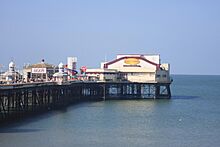 |
| Blackpool's first pier, designed by Eugenius Birch. It was made wider in 1897. Today it has The Joe Longthorne Theatre, five bars, games, and rides like a Venetian carousel. | ||
| Central Pier | 1868 | 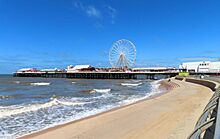 |
| Designed for a more popular crowd than North Pier. It was used for outdoor dancing, then roller skating and fairground rides. Today it has shops, bars, games, and rides, including a big wheel. | ||
| South Pier | 1893 | 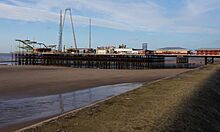 |
| Known as Victoria Pier until 1930. It had a fancy pavilion, shops, a bandstand, and photo stalls. It was for more upscale visitors. Today it has bars, food, games, and rides, including a 38m bungee jump. | ||
| Winter Gardens | 1878 | 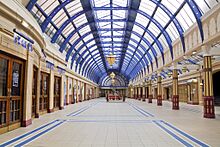 |
| It first had a glass-roofed Floral Hall for walking around, skating rinks, and the Pavilion Hall. Later additions included the Empress Ballroom (1896), Olympia (1930), themed rooms like the Spanish Hall (1931), and the Opera House (1939). A new Conference & Exhibition Centre opened in 2022. | ||
| Blackpool Tower | 1894 | 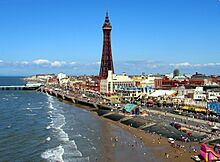 |
| Inspired by the Eiffel Tower, Blackpool Tower was the tallest man-made building in the British Empire when built. It is 518 feet (158 meters) tall. The Tower Dungeons opened in 2011. The Tower Circus has a water finale. The Tower Ballroom opened in 1898. Today, attractions include the Tower Eye, Ballroom, Circus, Dungeon, and Dino Mini Golf. | ||
| Grand Theatre | 1894 | 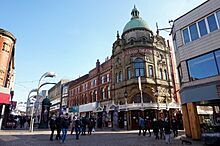 |
| Called 'Matcham's masterpiece'. It has a fancy outside and rich inside. It closed in 1972 and reopened in 1981. Today it hosts popular shows and ballet. | ||
| Pleasure Beach | 1896 | 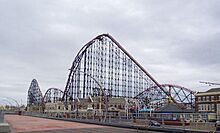 |
| Founded by W G Bean. It is still owned by Bean's family. Sir Hiram Maxim's Captive Flying Machine, a swing ride, was built in 1904 and is still there. When it opened in 1994, The Big One was the world's tallest roller coaster. Nickelodeon Land opened in 2011. | ||
| Madame Tussauds | 1900 | |
| Louis Tussaud, great-grandson of Marie Tussaud, opened waxworks in Blackpool in 1900. The Louis Tussaud's Waxworks opened on Central Promenade in 1929. It closed in 2010 and reopened as Madame Tussauds in 2011. | ||
| Illuminations | 1912 |  |
| Started to celebrate Princess Parade opening. Today, the Illuminations stretch 6.2 miles (10 km) and use over one million bulbs. They usually run for 66 nights in autumn. Since the Covid pandemic, they have been extended into winter. A celebrity switches on the lights each year. | ||
| Ripley's Believe it or Not | 1973 | |
| This 'odditorium' is based on Robert Ripley's collection. It was first on the Golden Mile. It moved near the Pleasure Beach in 1991. Blackpool's collection includes animal oddities and the world's smallest production car. | ||
| Blackpool Zoo | 1976 | |
| The zoo opened in 1972 on the site of an old airport. It housed many animals, including elephants, rhinos, and giraffes. Today it has over 1,000 animals. In 2023, it opened a new big cat area and a new facility for penguins. In summer 2023, it welcomed its first critically endangered Bornean orangutan baby in over two decades. | ||
| Sandcastle Waterpark | 1986 | |
| Built on the site of old outdoor baths. In 1986, it had two water slides and a wave pool. Many original features remain. Today it claims to be the UK's biggest indoor waterpark with 18 slides. | ||
| Sea Life | 1990 | |
| Located on Central Promenade. It opened with a transparent "tunnel of fear" through a huge tank. Now it has 2,500 aquatic creatures in 50 displays. | ||
| Peter Rabbit: Explore and Play | 2022 | |
| Based on Beatrix Potter's character. This interactive family attraction has challenges in themed zones. | ||
| Gruffalo & Friends Clubhouse | 2023 | |
| Based on children's stories by Julia Donaldson and Axel Scheffler. It has play zones inspired by The Gruffalo and other books. | ||
| Showtown | 2024 | |
| Blackpool's museum of entertainment opened in 2024. It shows Blackpool's entertainment history, including circus, shows, magic, and dance. It is on the first floor of the new Sands Venue Resort Hotel and Spa. | ||
Other Fun Attractions
| Attraction | Opened in | Picture |
|---|---|---|
| Golden Mile | 1897 | 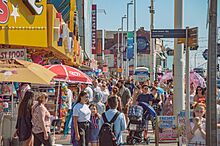 |
| The name for the Promenade between the North and South piers. It is 1.6 miles (2.6 km) long. It grew from traders who couldn't sell on the sands. Today it has many main attractions, games, and souvenir shops. | ||
| Pleasure Beach Arena | 1937 | |
| The oldest ice theater built for shows in the world. It opened in 1937 as the Ice Drome. The Hot Ice Show is performed here every year. The Arena is also open for public skating. | ||
| The Casino | 1940 |  |
| Built in 1913, it was never actually a casino. It had a restaurant, bar, shops, and a theater. Today it has the Paradise Room and Horseshoe theaters for magic and variety shows. It also has the White Tower restaurant. | ||
| Brooks Collectables | 1947 | |
| A family-run shop with a free museum upstairs. The museum has old toy collections and Blackpool souvenirs. | ||
| Princess Parade Crazy Golf Course | 1957 | |
| Located near Blackpool North Pier. It was restored and reopened in 2021. Volunteers helped with the two-year restoration. | ||
| Model Village | 1972 | |
| Shows miniature buildings of rural life across 2.5 acres of gardens. It is next to Stanley Park. | ||
| Coral Island | 1978 | |
| The largest of the town's many amusement arcades. It covers two acres of land. | ||
| Funny Girls | 1994 | |
| A cabaret drag bar. It first opened on Queen Street and now is in the old Odeon cinema. It features original performers like Betty Legs Diamond and DJ Zoe. In 2022, Ava King Cynosure became the first female drag queen to perform there regularly. | ||
| Pasaje Del Terror | 1998 | |
| An interactive walk-through horror attraction. It has scare actors in the basement of the Pleasure Beach Casino building. | ||
| Spitfire Visitor Centre | 2009 | |
| Based in Hangar 42 at Blackpool Airport. It has five Spitfire replicas. Visitors can sit in a cockpit or use a flight simulator. | ||
| Comedy Carpet | 2011 | |
| Located opposite Blackpool Tower. It is made of granite and concrete. It has jokes and catchphrases from hundreds of comedians. | ||
| Viva Blackpool | 2012 | |
| A cabaret showbar that hosts many acts and shows all year. | ||
| Tramtown | 2015 | 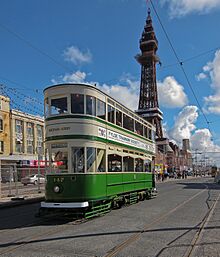 |
| This center offers tours of tram sheds and workshops. It also has heritage tram journeys, including illuminated tours and ghost tours. In 2023, it announced plans for a tram heritage center. | ||
| House of Secrets | 2021 | |
| Blackpool's first magic bar for families. It is in the Winter Gardens complex. It is owned by local magician Russ Brown. | ||
| Hole in Wand | 2022 | |
| A wizard-themed golf course. It is in the old Woolworths building on Blackpool Promenade. | ||
| Arcade Club | 2022 | |
| A retro arcade with over 200 games. It has classic games like Pac Man and Space Invaders. It also has modern games and sports like air hockey. | ||
Nature and Outdoors
| Attraction | Opened in | Picture |
|---|---|---|
| Beaches | N/a |  |
| Blackpool has "seven miles of golden sands." In 2016, they were named the second best shoreline in the world. Blackpool South beach also got Blue Flag status. Laws helped improve the beaches. In 2023, eight beaches on the Fylde Coast won Seaside Awards. | ||
| Stanley Park | 1926 |  |
| A 260-acre park with a boating lake, Art Deco café, and amphitheatre. It has sports facilities, a golf course, and a cricket club. The park is a Grade II* listed site. In 2005, a £5.5 million project helped restore the park. In 2022, a new skate park opened. In 2023, facilities like the athletics track and tennis courts were updated. The park has been voted the UK's favorite three times. | ||
Blackpool's Culture
Art in Blackpool
The Grundy Art Gallery opened in 1911 next to Blackpool Central Library.
Blackpool Art Society started in 1884. The Grundy brothers were important members. In 1913, the society began using the new Grundy Art Gallery for its yearly exhibition. The gallery includes the artwork "Blackpool Stands Between Us and Revolution."
Blackpool School of Arts opened in 1937. It has a gallery space for exhibitions. Famous artists like Jeffrey Hammond and Adrian Wilson studied there.
The Old Rock Factory, opened in 2011, has studios for artists. It was once used to make Blackpool rock candy. Its founder, Robin Ross, also started the Sand, Sea and Spray street art festival. This festival featured live street art in Blackpool from 2011 to 2016.
Abingdon Studios opened in 2014. It is an art space and studios for artists. It supports working-class and queer artists. In 2021, they created We're Still Here, a collection of LGBTQIA+ history in Blackpool.
HIVEArts is a gallery and arts group that hosts exhibitions. Tea Amantes is a tearoom and gallery that shows art by local artists.
Left Coast Arts
Left Coast is an arts group started in 2013. It creates creative activities in Blackpool and Wyre. One project, Real Estates, had artists live in local housing areas. This helped them connect with the community.
In response to a 2017 Financial Times article, Left Coast asked artists to share different views. Photographer Craig Easton created Is Anybody Listening?.
Left Coast helped fund the Art B&B project, which opened in 2019. It had 18 themed rooms. The B&B closed in October 2022.
In 2022, Left Coast opened Wash Your Words: Langdale Library & Laundry Room. It provides a place to wash clothes, read, and create art. It was praised for its "joyful design."
Aunty Social Community Arts
Aunty Social is a volunteer-run community arts group in Topping Street. It started in 2011. In 2013, it opened Charabanc, a shop selling local art. Aunty Social runs the online magazine Blackpool Social Club and the Winter Gardens Film Festival. It has a darkroom and library. It also hosts a Queer Craft Club and Heritage Craft workshops.
Knittaz With Attitude, a local textiles group, is an Aunty Social project. They have done several yarn bombing projects in public places. In 2022, the group created art to highlight safety concerns for women. The pieces were shown in Blackpool Central Library.
Public Art in Blackpool
Performing Arts
Theatre in Blackpool
In the 1930s, Blackpool's many theaters and cinemas could seat over 60,000 people.
The Theatre Royal opened in 1868. It later became the Tivoli Electric Theatre. It was destroyed by fire in 2009.
In 1874, the Indian Pavilion was built on North Pier for concerts. After fires, it was replaced by the Art Deco Pavilion Theatre in 1939. It is one of the few pier theaters left.
The Borough Theatre opened in 1877. It was torn down in 1972/73.
Her Majesty's Opera House, part of the Winter Gardens, was built in 1889. It was redesigned in 1910. The current Opera House opened in 1938. It seats 3,000 people. It was the largest theater in the country when it opened. It still stages touring musicals.
The Empire Theatre and Opera House opened in 1895. It became a circus venue in 1900. In 1929, it became the ABC cinema. The Beatles appeared there in 1964. It was torn down in 2014.
The Prince of Wales Theatre was built in 1879. It was replaced by the grand Alhambra in 1900. It later became the Palace Theatre in 1904. It was torn down in 1961.
The Grand Theatre was built in 1894. It hosts many types of shows and an annual pantomime. It has a youth theater company. In September 2023, Blackpool Council committed £500,000 for urgent repairs.
The Regent Cinema opened in 1921. It was a bingo hall from the 1970s. After renovation, it reopened as a cinema and live performance venue.
The Old Electric is Blackpool's newest theater. It opened in 2021 in the former Princess Electric Cinema. It is home to The Electric Sunshine Project, a community theater company.
Dance in Blackpool
Dance has been a big part of Blackpool's culture for 150 years. People first danced outdoors on the piers. This led to ballrooms opening. The Tower Ballroom opened in 1894, followed by the Empress Ballroom.
The Empress Ballroom was built in 1896. It was much grander than its rival. It had a capacity of 3,000. In 1934, it got a new dance floor with 10,000 strips of wood.
The first Blackpool Dance Festival was held in the Empress Ballroom in 1920. It had competitions for new sequence dances. In 1931, it hosted the first British Professional and Amateur Ballroom Championships. Today, about 50 countries are represented at eight annual festivals. Blackpool Dance Festival is known as 'the world's first and foremost festival of dancing'.
The current Tower Ballroom was designed by Frank Matcham. It opened in 1899. Its dance floor is 120 feet by 102 feet. It has 30,602 separate blocks of wood. The inscription above the stage is from Shakespeare. In 1956, the ballroom was badly damaged by fire. It took two years and £500,000 to restore. The BBC show Come Dancing was broadcast from the Tower Ballroom. Its new version, Strictly Come Dancing, has an annual Blackpool week. The Tower Ballroom is still popular for dancing. Its famous Wurlitzer organ still rises from below the stage.
In the 1900s, bandleaders created new dances. The Blackpool Walk was a dance craze in 1938. In 2020, a local dance company created a new social dance called The Blackpool Way.
House of Wingz, a dance company, aims to create a dance "scene" in Blackpool. It is the Blackpool partner for Breakin' Convention, a hip hop festival. In 2022, House of Wingz members won seven trophies at the UDO World Street Dance Championships. Skool of Street is their charity arm. It offers free classes for children who cannot pay.
Other dance schools in Blackpool include Phil Winstone's Theatreworks and Langley Dance Centre.
Amateur Dramatics
Blackpool has many amateur and community theater groups.
Junction Four Productions started in 1904 as Lytham Amateur Operatic Society. Blackpool & Fylde Light Opera Company has had annual shows since 1950. Blackpool Operatic Players has been performing since 1953.
In 2022, a blue plaque was put up at Michael Hall Theatre School. It marks where Marton Operatic Society performed from 1930 to 2002. The society closed in 2021.
Michael Hall Theatre School is a small theater and school. It was founded in 2003 by Michael Hall. His past students include Jodie Prenger.
TramShed is an inclusive theater company and charity. It offers performing arts to children and adults, including those with special needs. Cou-Cou Theatre Productions is a Community Interest Company started in 2018.
Music in Blackpool
Music Heritage
Blackpool has a rich music history. The first place for musical entertainment was Uncle Tom's Cabin in the 1860s.
The Wurlitzer organ at Blackpool Tower Ballroom was played by Reginald Dixon from 1930 to 1970. His performances were broadcast live. Phil Kalsall has been the main organist since 1977.
Lawrence Wright was a successful music publisher. He moved to Blackpool in the 1920s. He opened 20 song booths where musicians played his sheet music.
Blackpool was important for big bands playing jazz and swing from the 1930s to 1950s. Famous bands like Ted Heath and Joe Loss often performed.
After the war, Blackpool was a center for live entertainment outside London. It had many variety shows with popular music stars. Frank Sinatra performed twice in the early 1950s.
The 1960s were a golden era for Blackpool's music. Live music was everywhere. All the top British beat groups played in Blackpool. The Winter Gardens Empress Ballroom hosted rock, alternative, and indie bands. These included Queen and Blur.
Smaller venues like The Galleon bar and Mama & Papa Jenks attracted musicians. Mama & Papa Jenks hosted acts like the Eurythmics and the Buzzcocks. It became a punk venue.
John Lennon lived in Blackpool for a short time as a child. He often visited family there and watched musical acts. The Beatles were booked to play on South Pier in 1962. They became too famous for the venue. They later played at the ABC Theatre and Opera House in 1963 and 1964.
A The Rolling Stones concert at the Empress Ballroom on July 24, 1964, led to a riot. The venue was damaged. Blackpool Council banned the Rolling Stones from performing again. The ban was lifted 44 years later, but the band has not returned.
Jimi Hendrix played at the Odeon complex in 1967. Pink Floyd also played the Empress Ballroom and Opera House in 1967 and 1969.
Factory Records' band Section 25 formed in Blackpool in 1977. Another Blackpool band, Tunnelvision, also signed to the label.
Songs Inspired by Blackpool
Many musical artists are connected to Blackpool. These include Boston Manor, Chris Lowe, and Rae Morris. However, their hometown doesn't often appear in their music.
Blackpool has been mentioned in popular music for almost a century. Stanley Holloway's 1932 song The Lion and Albert tells a funny story about a child and a lion at Blackpool Zoo. George Formby wrote songs like Blackpool Prom and Sitting on the Top of Blackpool Tower. The George Formby Society still meets in Blackpool.
Later songs about Blackpool include Blur's This Is a Low and Soft Cell's Say Hello, Wave Goodbye. Manic Street Preachers sang Elvis Impersonator, Blackpool Pier.
Up The Pool by Jethro Tull was released in 1971. It reflected English identity. In Blackpool Tower Suite, World of Twist sang about the Tower as a female figure.
Blackpool-born singer Rae Morris's 2022 album Rachel@Fairyland pays tribute to her hometown. Songs mention Blackpool Tower and childhood memories. Music videos for her singles were filmed in Blackpool.
Many songs about Blackpool show it as a holiday spot for working-class people. Folk songs like Blackpool Belle speak of happy memories. Tatty Seaside Town by The Membranes reflects growing up there. The Fall's song Idiot Joy Showland talks about the town's artificial side.
Songs about Blackpool often show it as a place of freedom and fun. They often connect to English working-class identity.
Music Scenes
Blackpool has been important for music scenes like northern soul, punk, rave, and grime.
Locarno Mecca opened in 1965. It hosted acts like Bob Marley and the Wailers. It became a famous northern soul venue in the 1970s. Later, it was home to Federation, important in the 1990s house and rave scene. Blackpool still has strong ties to northern soul.
Blackpool's connection to punk in the 1970s was strong. It was known for local post-punk groups like The Membranes. Blackpool has hosted the annual Rebellion Festival since 1996. It is the largest independent punk music festival in the world.
In the mid-2010s, young MCs started showing their music on YouTube channels like Blackpool Grime Media (BGMedia). Artists like Afghan Dan and Millie B became known. Millie B's 2016 song M to the B became very popular online.
Blackpool has two independent music venues. Bootleg Social, opened in 2014, hosts touring bands and local musicians. The Waterloo Music Bar, since 2015, focuses on punk, rock, and metal bands. In Good Company is a local music group that helps musicians find gigs.
Film and TV in Blackpool
Blackpool has been featured in many films and TV shows. These include the 1934 film Sing as We Go with Gracie Fields. Other films are Forbidden (1949) and Funny Bones (1995).
The Japanese film Shall We Dance? (1996) ends with a scene in Blackpool. The Hollywood remake (2004) mentions Blackpool but doesn't show it.
Blackpool is the setting for Bhaji on the Beach (1993). The film Like It Is (1998) was partly filmed there. The TV series Funland (2005) was about a fictional, darker side of Blackpool.
The BBC TV series Blackpool (2004) and its follow-up Viva Blackpool (2006) are set in the town.
In 2006, Lion Television filmed The Great British Summer in Blackpool. The Royal Windsor Hotel was featured.
Blackpool was also shown in Channel 4's 999: What's Your Emergency? in 2012.
The Channel 5 series Blackpool Lights (2013) and Bargain Loving Brits in Blackpool (2017) also featured the resort.
The 2016 Tim Burton film Miss Peregrine's Home for Peculiar Children features Blackpool Tower.
Media in Blackpool
Newspapers covering Blackpool include the Blackpool Gazette and the Lancashire Evening Post.
The main local radio station is Central Radio North West. The former local station Radio Wave closed in 2020. Blackpool is also covered by BBC Radio Lancashire and other regional stations.
Bay Trust Radio is a hospital radio station run by volunteers. Fun Coast Digital received a license in 2022 to broadcast from Blackpool Tower.
Blackpool Social Club is an independent online arts and culture magazine. Other online publications include Lancs Live and The BPL Bible.
National TV with local news is provided by ITV Granada and BBC North West. Blackpool also has a local TV news service, That's Lancashire.
LGBTQ+ Community
Blackpool had its first gay pride celebration in 2006. Seaside resorts have often been welcoming to minority groups. Blackpool has a reputation for being a safe community for gay people. During World War II, many places for homosexual men to meet opened. In the 1990s, the town started promoting itself as a gay tourist spot. Blackpool has several bars and clubs for the LGBTQ+ community. These include Funny Girls, Flamingo, and the Flying Handbag. In 2021, 3.26% of Blackpool residents over 16 identified as gay men or lesbians. This is one of the highest percentages in England and Wales.
In 2022, We're Still Here was started. It is an oral history project about queer heritage in Blackpool. Blackpool Pride has included art and heritage events.
In October 2023, Blackpool Council launched a survey. It asked for ideas to celebrate the resort's LGBTQ+ heritage. This would build on the many gay venues in the north of the town center.
Twin Towns
Blackpool is twinned with:
- Bottrop, Germany
- Sanya, China
Blackpool's Sports
Blackpool has two main places for boxing fights: the Tower Circus Arena and the Winter Gardens. Both hold regular fight nights. Many professional boxers are from Blackpool.
Blackpool Cricket Club is the town's main cricket team. They play in the Northern Premier Cricket League. They have won the league 18 times. Their home is in Stanley Park.
The annual Blackpool Marathon takes place on the Promenade each April.
Football and Rugby
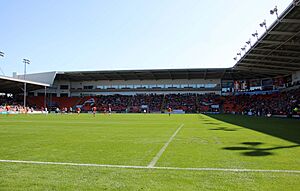
The town's professional football club is Blackpool F.C.. They have spent 31 seasons in the top division. They won the 1953 FA Cup Final. Famous former players include Sir Stanley Matthews and Jimmy Armfield. Other smaller football clubs in Blackpool are A.F.C. Blackpool and Squires Gate.
Blackpool Borough was the first professional rugby league club in town. They later moved and then closed. Blackpool Panthers were formed in 2004. They played at Bloomfield Road and then at Woodlands Memorial Ground. The club closed after the 2010 season.
Blackpool Stanley, Blackpool Scorpions, and Blackpool Sea Eagles are amateur rugby league clubs.
Blackpool used to host the Northern Rail Cup Final. It now hosts the annual 'Summer Bash' rugby league tournament at Bloomfield Road.
Blackpool also has a rugby union club, Blackpool RUFC. Their home ground is Norbreck Rugby Ground.
Golf
There are three golf clubs in Blackpool. Blackpool North Shore Golf Club opened in 1904. Blackpool Park Golf Club is in Stanley Park. Herons' Reach Golf Resort opened in 1992. An older club, Blackpool Golf Club, closed at the start of World War II.
Professional Wrestling
The Pleasure Beach's Horseshoe Show Bar used to host professional wrestling events. People could challenge wrestlers for cash prizes. Famous wrestlers like William Regal worked there. The booth closed in 1994.
The Tower Circus also often hosted wrestling shows. All Star Wrestling brought summer seasons to the venue. The Tower Ballroom hosted a World of Sport Wrestling TV show tour in 2019.
WWE held a tournament at the Empress Ballroom in January 2017. This was to crown the first WWE United Kingdom Champion. Tyler Bate won the tournament.
Several wrestlers have invested in Blackpool. Kendo Nagasaki owns the Trades Hotel. Shirley "Big Daddy" Crabtree worked as a lifeguard on Central Pier.
The Blackpool Combat Club, a wrestling group, was named after Blackpool.
Skateboarding
Ramp City is an indoor skatepark in Blackpool. It has wooden ramps and a large street section. It has one of the UK's biggest vert ramps. It hosts the UK Vert Series Seaside Sessions. In 2014, top UK female skater Lucy Adams named it one of her favorite parks. Ramp City also has a skate shop. In 2020, the park started hosting girls-only skate nights.
The Skate Like A Girl (SLAG) group is for female skaters in Blackpool. They aim to create safe skating places for women. They work with Reclaim Blackpool, a project mapping safety concerns in public places.
In May 2022, a new concrete skatepark was built in Stanley Park. This was after a community fundraising effort.
Live Like Ralph is a charity that honors local skater Ralph Roberts. It provides skateboards to young skaters. In 2023, it worked with Skool of Street to build an indoor skatepark called Ralph's House.
Disorder is a 2021 short film about skate spots in Blackpool. Curb Culture is a skateboarding magazine about local culture.
Blackpool's Religion
Blackpool has many Christian churches. These include 18 Anglican and 10 Catholic churches. Other Christian groups are also present. The Shrine of Our Lady of Lourdes is being turned into a community center.
Blackpool used to have two synagogues for its Jewish population. Now there is one. The Blackpool Reform Jewish Congregation is for the Reform population. The Blackpool United Hebrew Congregation (Orthodox) closed in 2012 due to fewer members.
There is a Buddhist Centre in North Shore. There are also two mosques for the Muslim population. The Blackpool Central Mosque & Islamic Community Centre provides prayer facilities.
Blackpool also has small communities of Baháʼís, Hindus, Jains, Mormons, and Sikhs. The Blackpool Faith Forum started in 2001. It helps different faith groups talk to each other. It also promotes a multifaith community. A youth forum, BIFFY, was started in 2007.
Blackpool's Education
Blackpool has 29 state primary schools and eight state secondary schools. There are also many activities for children and young people. Some of these are run by Blackpool Young People Services.
Blackpool's Transport
Air Travel
Blackpool Airport used to have regular flights across the UK and Europe. The airport is just outside Blackpool's border. It is one of the oldest airports in the UK. It was active from the 1930s to 2014, and then from December 2014. Scheduled flights stopped in 2017. Now, to fly to Blackpool, you use Liverpool John Lennon Airport or Manchester Airport. Both are about 40 miles (64 km) away.
In 1927, the council announced an airfield near Stanley Park. This became Stanley Park Aerodrome. It offered flights to the Isle of Man. The airport opened in 1929. It closed in 1947. The land is now home to Blackpool Zoo and a hotel. The old airport hangars are still used by Blackpool Zoo.
Bus and Coach Services
- Blackpool Transport runs the main bus services in and around Blackpool.
- Stagecoach Merseyside & South Lancashire runs regional bus and coach services.
- National Express runs long-distance coach services.
Bus and coach facilities include:
- Blackpool Talbot Road Bus Station: This was the main bus station but is now a gym. Blackpool Transport stopped using it in the early 2000s. They now use Market Street and Corporation Street.
- Blackpool Central Coach Station: This is the main coach station for National Express.
- Blackpool Lonsdale Road Coach Station: This was the main coach station for South Shore. It is mainly used by independent coach operators.
- Blackpool Colosseum Bus & Coach Station: This was the main bus and coach station in South Shore. It was torn down for a supermarket.
Train Travel
Train companies that serve Blackpool are:
Train stations in the town are:
- Blackpool North
- Blackpool Pleasure Beach
- Blackpool South
- Layton
- Squires Gate (serves Blackpool Airport)
Blackpool once had two large train terminals. They had over 30 platforms, mostly for summer visitors. Blackpool Central closed in 1964. Blackpool North was mostly rebuilt as a smaller station. The old route into Blackpool Central is now a road from the M55 motorway. The line into Blackpool via Lytham St Annes now has a station for Blackpool Pleasure Beach. It ends at Blackpool South station. The line into North station is now more important.
Tram Services
The Blackpool Tramway runs from Starr Gate in Blackpool to Fleetwood. It is the only original tramway still running in the UK. The tramway started in 1885. It is one of the oldest electric tramways in the world. Blackpool Transport runs it. The tramway is 11 miles (18 km) long. It carries 6.5 million passengers each year.
For a long time, it was the only working tramway in the UK outside of museums. It was also the UK's first electric system. Now, there are other tramways in places like Manchester and Sheffield.
In 2008, the government agreed to fund a big upgrade of the track. The government gave £60.3 million. Blackpool Council and Lancashire County Council also contributed. The entire tramway was upgraded. Sixteen new trams were added.
In April 2012, the tramway reopened after the big reconstruction. The 16 Flexity 2 trams run daily services. Some old double-decker trams were made wider to work with the new ones. They provide extra space in summer. Some unmodified old trams also run a special heritage service on weekends and holidays.
An extension to Blackpool North railway station was planned. It was delayed but opened in May 2024.
Freedom of the Borough
The following people and military units have received the Freedom of the Borough of Blackpool. This is a special honor.
Individuals Honored
- William Henry Cocker: 1897.
- Joseph Heap: 1907.
- John Bickerstaffe: 1912.
- James Fish: 1912.
- James Ward: 1914.
- Robert Butcher Mather: 1914.
- John Grime: 1915.
- James Heyes: 1915.
- David Lloyd George: 1918.
- Brigadier General Thomas Edward Topping: 1922.
- Thomas Bickerstaffe: 1926.
- Sir Lindsay Parkinson: 1926.
- William Henry Broadhead : 1926.
- Henry Brown : 1928.
- Samuel Hill : 1928.
- John Collins : 1928.
- Thomas Fielding : 1928.
- Edward Stanley, 17th Earl of Derby : 1934.
- Josiah Stamp, 1st Baron Stamp: 1937.
- Sir Cuthbert Cartwright Grundy: 1938.
- Sir Winston Churchill: 1946.
- Field Marshal Lord Montgomery of Alamein: 1948.
- Eli Hey Howe: 1950.
- Tom Gallon Lumb: 1950.
- Thomas Fenton: 1950.
- Sir Harold R Grime : 1950.
- Rhodes William Marshall: 1973.
- Harold Grimbledeston: 1973.
- Ernest Alfred Machin: 1973.
- Joseph Shepherd Richardson: 1973.
- Leonard Broughton: 1973.
- Raymond Jacobs: 1984.
- Walter Uriah Robinson: 1984.
- Harold Leslie Hoyle: 1984.
- Percy Patrick Hall: 1984.
- Stan Mortensen: 1989.
- Doris Thompson: 2003.
- Jimmy Armfield: 2003.
Military Units Honored
- R (Blackpool) Battery 288 (2nd West Lancashire) Light Anti-Aircraft Regiment Royal Artillery, Territorial Army: 1961.
- HMS Penelope RN: 1990.
- 12th Regiment Royal Artillery: 2005.
- The Duke of Lancaster's Regiment: 2017.
- The Loyal North Lancashire Regiment.
- HMS Triumph RN: 2017.
Images for kids
See also
 In Spanish: Blackpool para niños
In Spanish: Blackpool para niños
- List of people from Blackpool
- Blackpool High Tide Organ
- Listed buildings in Blackpool





